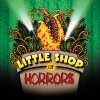Filichia Features: He’s Hans Christian Andersen – JR.

Filichia Features: He’s Hans Christian Andersen – JR.
Here’s an abridged musical where the term "JR." is meant literally.
Until now, all Jr. titles in the Music Theatre International catalogue have used that abbreviation to indicate that a famous musical had been cut to an hour or so for grade or middle school consumption.
But Hans Christian Andersen JR., is not merely a shortened version of the famous film that screenwriter Moss Hart and songwriter Frank Loesser penned in 1952. This Jr. title actually deals with a boy named Hans Christian who's the son and namesake of Hans Christian Andersen, Sr. -- thus, Hans Christian Andersen JR..
Timothy Allen McDonald has completely dispensed with Hart's screenplay and has created a new story that is far more satisfying than the film’s. No, you can't license it yet -- the final product is about 18 months away -- but time goes fast, so keep Hans Christian Andersen JR. in mind for 2018, which will be here before you know it.
Based on the workshop that was aired earlier this month, this will be an ideal show for many of you. Although this is a mere 70-minute version, McDonald has managed to retain all the songs as well as including additional ditties that Loesser wrote for the 1949 film Red, Hot and Blue.
Well, why not? McDonald noticed that Betty Hutton-Victor Mature movie included a parody on Hamlet. Considering that Shakespeare’s classic play took place in Denmark – as does Hans Christian Andersen – McDonald found a way to incorporate Loesser’s “Hamlet” production number into the story – quite successfully, in fact.
When McDonald isn’t writing (superb) librettos, he’s the CEO of iTheatrics, which specializes in furnishing the middle school market with musicals. Each year, the company picks a few hit shows, condenses them into Jr. versions and does a pilot program in New York with a gaggle of kids -- no fewer than 46 for this one! The students come from various walks of life and locales, but the one thing they have in common is a fierce devotion to musical theater.
Marty Johnson, an iTheatrics director who staged Hans, told us before the show began that the kids came to The 52nd Street Project (on Tenth Avenue) only five days earlier at 9 a.m. but the show was already cast by noon. Twenty-eight hours later, the performers were ready to show their all.
“Ready” indeed. What confidence they had when they walked in! It didn’t flag a whit for the next hour-plus.
Onto McDonald’s new story: Hans – now a tween – is with his parents in a horse-drawn carriage en route to “Wonderful Copenhagen” (as the Loesser song goes) in the fall of 1823. Hans is such a bright lad that he's been given a scholarship to the Royal Academy. His parents are proud, but Hans is scared. Because he's the son of a tradesman and the other students in the school come from loftier backgrounds, he's worried. "What if the other kids think I'm weird?" he wonders – hardly the first or last adolescent to think that way.
His parents distract him, however, by telling stories of their own invention. They may not be professional writers, but they have a way with words. We’ll see that good genes have given Hans the same talent.
When Hans arrives, he immediately infers that he may well have far more trouble with Headmistress than the other students. As she imperiously says with a condescending finger-wag to him, “Even a commoner can have an education.”
That makes Hans feel like a five-day-old Danish pastry. What’s worse is that Headmistress seems to be right when Hans does miserably at math.
McDonald’s message that we can’t be good at everything is an important one. It should give encouragement to today’s students who believe that if they’re bad in one subject, they’re automatically failures. No, they are not, as Hans will prove within the next half-hour.
If the truth be known, however, Hans is at fault, too. As the other kids do their musical math -- “Two and two are four; four and four are eight, etc.” -- Hans is distracted by an “Inchworm” (as one of Loesser’s most beautiful songs goes).
Noting his interest is a girl in a wheelchair. She’s no ordinary lass; she’s no less than Princess Caroline, who was born with a club foot. She’d like to walk, but that would require a cane – which her mother The Queen absolutely forbids. Her Highness believes that a wheelchair gives a more regal impression because it seems more like a throne.
Hans is taken by Caroline, but denies it, in the way that so many tween boys do. Still, he’s thrilled that “I’m friends with a princess!”
“The invisible princess,” Caroline laments, referring to her sister, the glorious-looking (and terribly stuck-up) Princess Wilhelmina. To make Caroline feel better about her disability, Hans creates the story of another girl who couldn’t walk: The Little Mermaid.
Caroline loves the tale, which makes Hans increasingly believe in his story-telling abilities. Next comes “The King’s New Clothes” – which is of course, “The Emperor’s New Clothes,” in which haberdashers tell their ruler that anyone who can’t see their impressive new suits is automatically stupid. Actually, there ARE no new suits, but His Highness won’t admit that he sees nothing, lest everyone think that their monarch is a moron.
Loesser chose the word “King” and discarded “Emperor” to save two syllables. But he had plenty to dispense, as the king exclaims “The suit of clothes is altogether, but altogether, it's altogether the most remarkable suit of clothes that I have ever seen.” When he goes out in his new duds – meaning in the nude – one little child says “The King is IN the altogether, but altogether, the altogether! He's altogether as naked as the day that he was born!”
The moral of the story – that kings need to sustain the illusion that they’re infallible while innocent children tell the truth – shocks nearby policemen. They arrest Hans and are on their way to the clink. But suddenly, who steps forward to support Hans? Headmistress who’s heard the story, too, and recognizes that while Hans can’t compute a square root, he can spin a yarn. She shoos away the lawmen (because, I’d like to think, they were her former students and are still intimidated by her) and Hans goes free.
It’s a win-win situation. Headmistress and Hans learn that first impressions aren’t a lifetime sentence; you CAN change someone’s opinion about you. Just do what you do best, and you may find that people will come around and appreciate you.
Headmistress comes to believe so strongly in Hans’ talent that she encourages him to write a new version of Hamlet that the other students could do as this year’s school play. And just as the Thai kids adapt Uncle Tom’s Cabin into The Small House of Uncle Thomas, these students do the Danish modern version found in Red, Hot and Blue. It also gives Hans’ Hamlet and Princess Caroline’s Ophelia the chance to sing “No Two People (Have Ever Been So in Love).”
McDonald doesn’t end the tale there, but allows for some poignancy. Hans’ father is seriously injured in an accident, but does live long enough to hear “The Ugly Duckling,” the tale of a hideous mallard who time proves is a beautiful swan. Says Senior to Junior, “You’re our swan.”
Similarly speaking, The Queen is moved enough by “The Little Mermaid” to sanction Princess Caroline’s walking with a cane. McDonald won’t go so far to come out and say that Hans will wind up as Prince Hans, but we know that he’ll have a much better fate than Prince Hamlet.
You may e-mail Peter at pfilichia@aol.com. Check out his weekly column each Monday at www.broadwayselect.com and Tuesday at www.masterworksbroadway.com. His book, The Great Parade: Broadway’s Astonishing, Never-To-Be Forgotten 1963-1964 Season is now available at www.amazon.com.

























